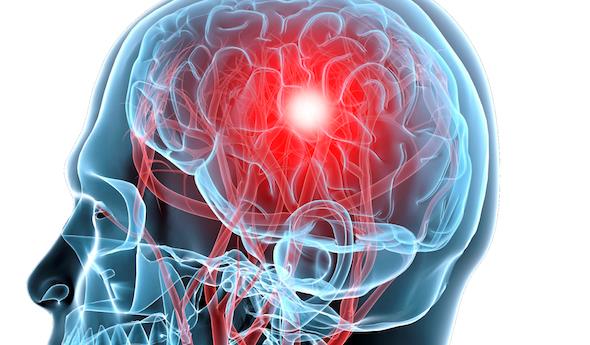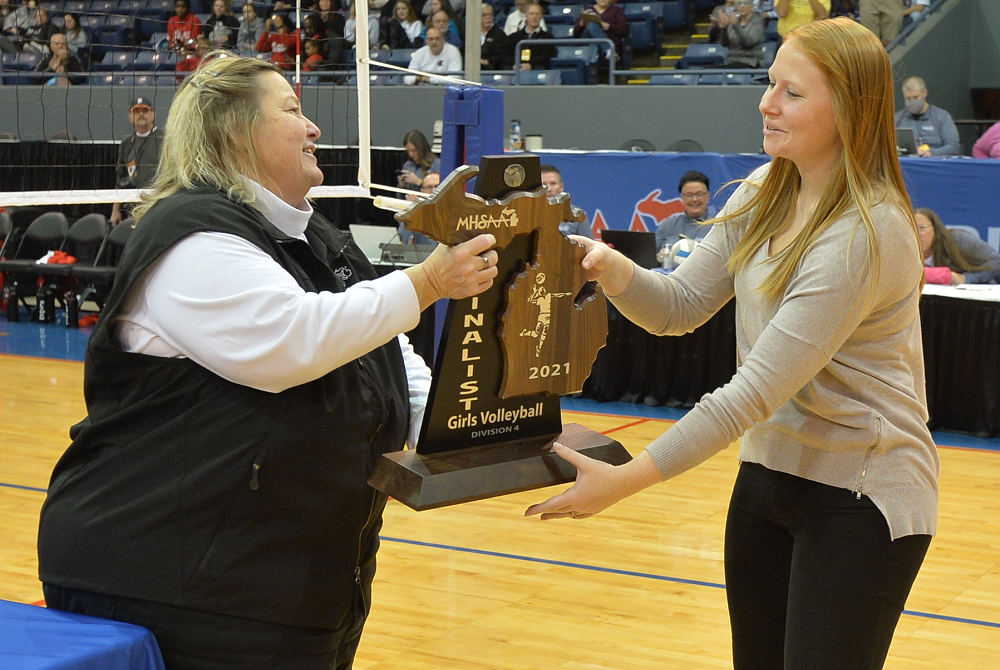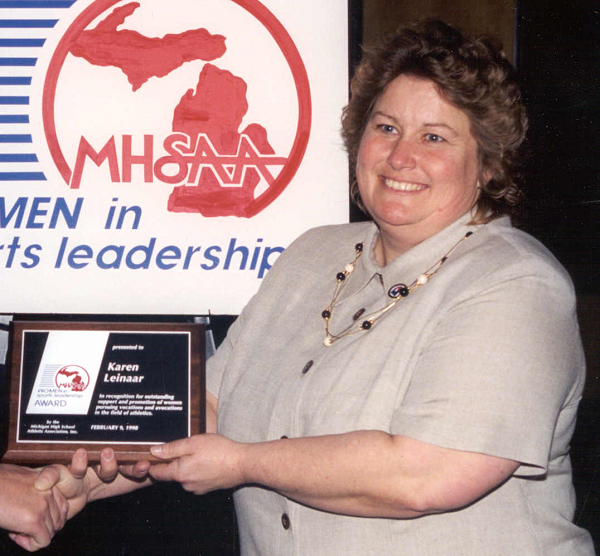
2017-18 Report Shows Fewer Concussions
August 8, 2018
By Geoff Kimmerly
Second Half editor
Concussions are down, according to data compiled by the Michigan High School Athletic Association during its third year of collecting head injury reports from member high schools.
The work is not done – but this year’s data reinforces trends that emerged during the first two years of reporting and will assist the MHSAA as it explores solutions to continue reducing the incidence of head injuries in school sports.
The 2017-18 concussion report found a 9.6-percent decrease in the number of confirmed concussions from the previous year. Student-athletes at MHSAA member high schools encountered during 2017-18 a total of 3,580 head injuries – or 4.8 per member school, compared to the 2016-17 average of 5.2. Total participation in MHSAA sports for 2017-18 was 284,920 – with students counted once for each sport he or she played – and only 1.3 percent of participants experienced a head injury, down from 1.4 in 2016-17 and 1.6 percent the first year of the study.
As first mandated in 2015-16, member schools are required to report head injuries to the MHSAA identifying the sport that each student-athlete was participating in and whether the injury was sustained during practice or competition. Schools also are required to designate at which level – varsity, junior varsity or freshman – the injury occurred.
The full report of all head injuries experienced during 2017-18 by student-athletes at MHSAA member high schools – including percentages by sport (per 1,000 participants), gender and team level, as well as data tracking when athletes returned to play – is available by clicking here.
Consistent with the first two years of the study, the MHSAA received data from more than 99 percent of its member high schools after the fall, winter and spring seasons and continued to track each injury report through its conclusion this summer. Member junior high and middle schools also were allowed, although not mandated, to report their potential head injuries; and those findings are not part of the published report.
The decrease in overall head injury reports collected for 2017-18 follows a similar reduction from 2015-16 to 2016-17 – and brings the total decrease to 19.6 percent fewer reports since the first year of the study.
MHSAA Executive Director John E. “Jack” Roberts noted that the decreases in reports, both year to year and since the first year of the survey, likely have some relation to year-to-year fluctuation, refinement of the follow-up reporting process and a better understanding by schools of what is not to be included for the survey – including head injuries not diagnosed as concussions and head injuries that did not take place during MHSAA-sponsored activities.
However, the findings of this year’s study – and their similarities to the findings from the first two surveys – has begun to clarify the identification and understanding of trends. Continuing to emerge perhaps most prominently is the higher incidence of concussion reports from girls sports – and pertinent questions about physiological and social causes behind those results.
“With three years of reporting by virtually 100 percent of our high schools, what we’re learning is no longer anecdotal; the results are beginning to identify valid trends and genuine issues that need to be addressed,” Roberts said. “For example, it’s even clearer than before that girls are reporting three times the number of concussions as boys when comparing similar sports – soccer, basketball and baseball versus softball. As a result, we’ve already begun to incorporate these gender differences into our coaches education, and the writers of high school playing rules are obligated to focus on these gender differences as well.”
Although the total number of confirmed concussions was significantly lower again in 2017-18, a number of findings detailing those injuries fell in line with results of the first two surveys.
Boys experienced 2,373– or 66 percent – of those injuries, the same ratio as 2016-17, and not surprisingly as boys have a much higher participation in contact sports. More than half of head injuries – 56 percent – were experienced by varsity athletes, which for the second year also fell within a percent difference of the previous year’s findings.
A total of 2,330 head injuries – or 65 percent – came in competition as opposed to practice. More than half took place during either the middle of practice or middle of competition as opposed to the start or end, and 52 percent of injuries were a result of person-to-person contact. The MHSAA also asked schools to report the number of days between the head injury and the athlete’s return to activity – and the two largest groups, both at 24 percent, returned to activity after either 6 to 10 days of rest or 11 to 15. All of these findings were within 1-3 percent of those discovered from the 2016-17 data.
Contact sports again revealed the most head injuries. Ranking first was football, 11 and 8-player combined, with 41 head injuries per 1,000 participants – a decrease for the second straight year, this time from 44 head injuries per 1,000 participants in 2016-17 and down from 49 head injuries per 1,000 football participants shown by the first study in 2015-16.
Ice hockey repeated with the second-most injuries per 1,000, with 32 (down from 36 injuries per 1,000 from 2016-17 and 38 per 1,000 in 2015-16), and girls soccer and wrestling tied for third with 25 head injuries per 1,000 participants – girls soccer down from 28 head injuries per 1,000 participants and wrestling down from 26 per 1,000 in 2016-17.
Also consistent with 2016-17, the next five sports (after football and hockey) to show the highest incidences of head injuries were girls sports – girls soccer followed by girls basketball (22 per 1,000), girls competitive cheer (20) and girls lacrosse (20). Boys lacrosse (17), girls gymnastics (16) and boys soccer (12) were the only other sports to show double-digit head injuries per 1,000 participants.
Females again reported significantly more concussions than males playing the same or similar sports – soccer, basketball and baseball/softball. Female soccer players reported more than double the concussions per 1,000 participants as male soccer players (25 to 12), while female basketball players also reported more than double the number of concussions per 1,000 participants (22 to 9). Softball players reported seven concussions per 1,000 participants, and baseball players reported three per 1,000. Although the percentage differences vary from year to year, the results of all three comparisons remained consistent with what the survey found in 2015-16 and 2016-17.
The MHSAA in 2018-19 is directing its sport committees to focus on a pair of questions – how to increase participation and how to make their specific sports safer – the latter aiming to put some of what has been learned from concussion reporting into practice. The MHSAA also is continuing to invite Michigan’s universities, health care systems and the National Federation of State High School Associations (NFHS) to take part in analyzing the data and resulting questions that have arisen during the past three years.
“Regrettably, I do not see a nationwide head injury reporting effort likely,” Roberts said. “First, it’s hard to coordinate 50 states’ efforts. And second, if left to medical professionals, the survey tool might become so cumbersome that schools would be reluctant to participate – and certainly, it would not get the 99.9 percent cooperation that we’ve enjoyed from schools over these three years.”
Schools report possible concussions online via the MHSAA Website. Reports are then examined by members of the MHSAA staff, who follow up with school administrators as those student-athletes continue to receive care and eventually return to play. Student privacy is protected.
The reporting of possible concussions is part of a three-pronged advance by the MHSAA in concussion care begun during the 2015-16 school year. The MHSAA completed in spring 2017 the largest-ever state high school association sideline concussion testing pilot program, with a sample of schools from across the state over two years using one of two screening tests designed to detect concussions. The MHSAA also was the first state association to provide all participants at every member high school and junior high/middle school with insurance intended to pay accident medical expense benefits – covering deductibles and co-pays left unpaid by other policies – resulting from head injuries sustained during school practices or competitions and at no cost to either schools or families.
Previously, the MHSAA also was among the first state associations to adopt a return-to-play protocol that keeps an athlete out of activity until at least the next day after a suspected concussion, and allows that athlete to return to play only after he or she has been cleared unconditionally for activity by a doctor (M.D. or D.O.), physician’s assistant or nurse practitioner.
In addition, the MHSAA’s Coaches Advancement Program – which includes courses that must be completed by all varsity head coaches hired for the first time at a member school – provides substantial instruction on concussion care. Separately, rules meetings that are required viewing for high school varsity and subvarsity head and assistant coaches at the start of each season include detailed training on caring for athletes with possible head injuries.

2023 Forsythe Award Celebrates Leinaar's 40 Years Dedicated to School Sports
By
Geoff Kimmerly
MHSAA.com senior editor
March 8, 2023
Few people in Michigan have had a longer-lasting influence on the rules and policies of educational athletics than Frankfort’s Karen Leinaar, who has served in several roles locally, statewide and nationally over more than 40 years contributing to the school sports community.
Thank you, Bill Baker.
The longtime teacher, coach, principal and superintendent during a career that stretched across multiple schools – including Leinaar’s growing up, Delton Kellogg – made an impression on the standout multi-sport athlete before she graduated from high school in 1977. Baker’s philosophy and work led Leinaar to study education at Michigan State University and then brought her back as Delton’s athletic director to begin four decades of making the same impact on children in her hometown and eventually in hometowns all over Michigan and beyond.
Baker died in 2009, but not before continuing to mentor Leinaar through many good times and tough ones.
“The man had two daughters that I grew up with, his wife was a teacher, and he demonstrated to all of us – he never missed an event – that we were important to him. That even though we weren’t his kids, we were his kids and athletics was a way to help kids become better people – and for some kids it was the only thing that they had positive in their life,” Leinaar said. “And he made it known just to that individual kid how important their participation was and their involvement, and how that helped them become the person that they were.
“That to me was such an example of how to help people be good people, that I just took that role on.”
It’s a role in which she continues to serve. Leinaar began her career as an athletic administrator in 1982, and as the interim athletic director currently at Frankfort High School is serving her fifth district in that position. Since June 2019, she also has served as executive director of the Michigan Interscholastic Athletic Administrators Association (MIAAA), the professional organization for school sports administrators in the state with a membership of nearly 700.
 To recognize that longtime and continuing impact, Leinaar has been named the 2023 honoree for the Michigan High School Athletic Association’s Charles E. Forsythe Award.
To recognize that longtime and continuing impact, Leinaar has been named the 2023 honoree for the Michigan High School Athletic Association’s Charles E. Forsythe Award.
The annual award is in its 46th year and named after former MHSAA Executive Director Charles E. Forsythe, the Association's first full-time and longest-serving chief executive. Forsythe Award recipients are selected each year by the MHSAA Representative Council, based on an individual's outstanding contributions to the interscholastic athletics community.
Leinaar also served 22 years on the MHSAA’s Representative Council and a four-year term from 2009-13 on the Board of Directors for the National Federation of State High School Associations (NFHS), and just last week was named to the 2023 class of the National Interscholastic Athletic Administrators Association (NIAAA) Hall of Fame.
“It is impossible even to estimate the number of students, coaches, administrators and others who have been affected by the work Karen Leinaar has done to make school sports the best they can be – not only in her communities, but across Michigan and throughout the country,” MHSAA Executive Director Mark Uyl said. “There are few who have equaled her dedication and her support and promotion of the ideals of school-based sports. She has always placed an emphasis on being in the room, on the field or at the arena, actively participating in her leadership roles, and our programs are better for it.”
Leinaar first served as athletic director at Delton Kellogg for nearly 17 years, from March 1982 through October 1998. She spent three years at Gaylord, then 8½ at Benzie Central before taking over at Bear Lake in November 2010 and spending the next decade organizing athletic programs for students in grades 5-12 before retiring in January 2021. She came out of retirement to return to the athletic director’s chair this past fall as interim AD at Frankfort. She has completed nearly four years as MIAAA executive director, moving into that position after previously serving nine years as an assistant to the executive.
Leinaar began her service on the Representative Council in Fall 1999 and completed her last term as a statewide at-large representative at the Fall 2021 meeting.
She has been honored several times for her contributions. She received the MHSAA’s Women In Sports Leadership Award in 1998, a Citation from the NFHS in 2000, and she was named MIAAA Athletic Director of the Year in 2001. She received an MHSAA’s Allen W. Bush Award in 2014 – recognition given for work done generally behind the scenes and with little attention.
“This is the top of the mountain, per se. This one does mean so much,” Leinaar said of the Forsythe Award. “The names that are associated with this over the years, I never thought I’d be put in that group.”
Leinaar remains a continuous source of support at a multitude of MHSAA championship events, and during her time on Council was one of the most frequent representatives handing out trophies and medals to champions and runners-up at Finals events. She began while athletic director at Delton Kellogg hosting the MHSAA Volleyball Finals in Class B and Class C and continues to assist with those championships now played at Kellogg Arena in Battle Creek.
She also hosted Competitive Cheer Finals at Delton Kellogg in 1996 and 1997, Ski Finals while at Gaylord, and many more championship events across the Lower Peninsula. She continues to assist at the MHSAA’s Lower Peninsula Cross Country and Track & Field Finals.
After attending Delton Kellogg High School, Leinaar earned a bachelor’s degree in physical education, health and recreation, with a minor in driver education, from MSU in 1982. She completed a master’s in athletic administration from Western Michigan University in 1994.
Leinaar has been a member for 40 years of both the MIAAA and NIAAA, and has served as chairperson of the MIAAA Annual Conference and awards chairperson for both the state and national bodies. She’s also served as chairperson of the MIAAA’s Exemplary Athletic Program.
Past recipients of the Charles E. Forsythe Award
1978 - Brick Fowler, Port Huron; Paul Smarks, Warren
1979 - Earl Messner, Reed City; Howard Beatty, Saginaw
1980 - Max Carey, Freesoil
1981 - Steven Sluka, Grand Haven; Samuel Madden, Detroit
1982 - Ernest Buckholz, Mt. Clemens; T. Arthur Treloar, Petoskey
1983 - Leroy Dues, Detroit; Richard Maher, Sturgis
1984 - William Hart, Marquette; Donald Stamats, Caro
1985 - John Cotton, Farmington; Robert James, Warren
1986 - William Robinson, Detroit; Irving Soderland, Norway
1987 - Jack Streidl, Plainwell; Wayne Hellenga, Decatur
1988 - Jack Johnson, Dearborn; Alan Williams, North Adams
1989 - Walter Bazylewicz, Berkley; Dennis Kiley, Jackson
1990 - Webster Morrison, Pickford; Herbert Quade, Benton Harbor
1991 - Clifford Buckmaster, Petoskey; Donald Domke, Northville
1992 - William Maskill, Kalamazoo; Thomas G. McShannock, Muskegon
1993 - Roy A. Allen Jr., Detroit; John Duncan, Cedarville
1994 - Kermit Ambrose, Royal Oak
1995 - Bob Perry, Lowell
1996 - Charles H. Jones, Royal Oak
1997 - Michael A. Foster, Richland; Robert G. Grimes, Battle Creek
1998 - Lofton C. Greene, River Rouge; Joseph J. Todey, Essexville
1999 - Bernie Larson, Battle Creek
2000 - Blake Hagman, Kalamazoo; Jerry Cvengros, Escanaba
2001 - Norm Johnson, Bangor; George Lovich, Canton
2002 - John Fundukian, Novi
2003 - Ken Semelsberger, Port Huron
2004 - Marco Marcet, Frankenmuth
2005 - Jim Feldkamp, Troy
2006 - Dan McShannock, Midland; Dail Prucka, Monroe
2007 - Keith Eldred, Williamston; Tom Hickman, Spring Lake
2008 - Jamie Gent, Haslett; William Newkirk, Sanford Meridian
2009 - Paul Ellinger, Cheboygan
2010 - Rudy Godefroidt, Hemlock; Mike Boyd, Waterford
2011 - Eric C. Federico, Trenton
2012 - Bill Mick, Midland
2013 - Jim Gilmore, Tecumseh; Dave Hutton, Grandville
2014 - Dan Flynn, Escanaba
2015 - Hugh Matson, Saginaw
2016 - Gary Hice, Petoskey; Gina Mazzolini, Lansing
2017 - Chuck Nurek, Rochester Hills
2018 - Gary Ellis, Allegan
2019 - Jim Derocher, Negaunee; Fredrick J. Smith, Stevensville
2020 - Michael Garvey, Lawton
2021 - Leroy Hackley Jr., Byron Center; Patti Tibaldi, Traverse City
2022 - Bruce Horsch, Houghton
PHOTOS (Top) Karen Leinaar, left, awards the 2022 Division 4 volleyball finalist trophy to Indian River Inland Lakes coach Nicole Moore. (Middle) Leinaar accepts the MHSAA's Women In Sports Leadership Award in 1998.

